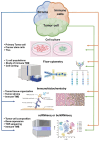Pediatric Solid Cancers: Dissecting the Tumor Microenvironment to Improve the Results of Clinical Immunotherapy
- PMID: 38542199
- PMCID: PMC10970338
- DOI: 10.3390/ijms25063225
Pediatric Solid Cancers: Dissecting the Tumor Microenvironment to Improve the Results of Clinical Immunotherapy
Abstract
Despite advances in their diagnosis and treatment, pediatric cancers remain among the leading causes of death in childhood. The development of immunotherapies and other forms of targeted therapies has significantly changed the prognosis of some previously incurable cancers in the adult population. However, so far, the results in pediatric cohorts are disappointing, which is mainly due to differences in tumor biology, including extreme heterogeneity and a generally low tumor mutational burden. A central role in the limited efficacy of immunotherapeutic approaches is played by the peculiar characteristics of the tumor microenvironment (TME) in pediatric cancer, with the scarcity of tumor infiltration by T cells and the abundance of stromal cells endowed with lymphocyte suppressor and tumor-growth-promoting activity. Thus, progress in the treatment of pediatric solid tumors will likely be influenced by the ability to modify the TME while delivering novel, more effective therapeutic agents. In this review, we will describe the TME composition in pediatric solid tumors and illustrate recent advances in treatment for the modulation of immune cells belonging to the TME.
Keywords: CAR-T cells; immunotherapy; pediatric solid tumor; tumor microenvironment.
Conflict of interest statement
The authors have no conflicts of interest to declare.
Figures


References
-
- Maude S.L., Laetsch T.W., Buechner J., Rives S., Boyer M., Bittencourt H., Bader P., Verneris M.R., Stefanski H.E., Myers G.D., et al. Tisagenlecleucel in Children and Young Adults with B-Cell Lymphoblastic Leukemia. N. Engl. J. Med. 2018;378:439–448. doi: 10.1056/NEJMoa1709866. - DOI - PMC - PubMed
-
- Byron S.A., Hendricks W.P.D., Nagulapally A.B., Kraveka J.M., Ferguson W.S., Brown V.I., Eslin D.E., Mitchell D., Cornelius A., Roberts W., et al. Genomic and Transcriptomic Analysis of Relapsed and Refractory Childhood Solid Tumors Reveals a Diverse Molecular Landscape and Mechanisms of Immune Evasion. Cancer Res. 2021;81:5818–5832. doi: 10.1158/0008-5472.CAN-21-1033. - DOI - PMC - PubMed
Publication types
MeSH terms
Grants and funding
LinkOut - more resources
Full Text Sources
Medical

